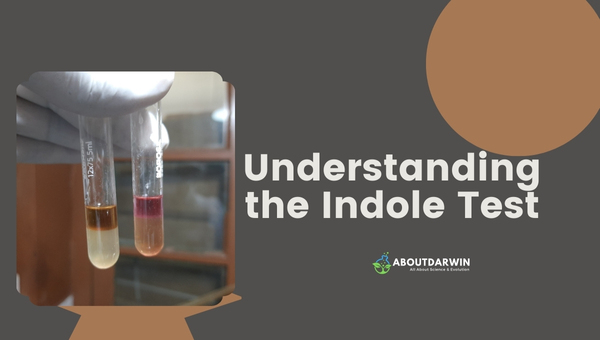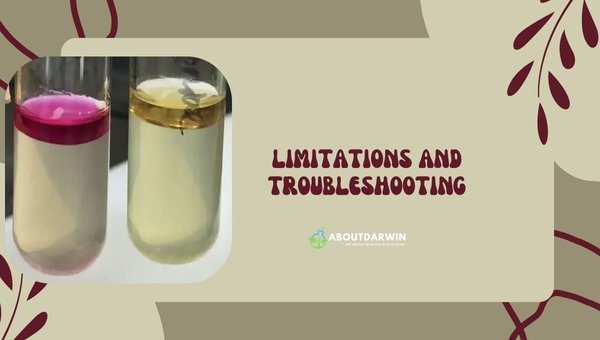Physical Address
304 North Cardinal St.
Dorchester Center, MA 02124
Do you sometimes find yourself puzzled over microbial analyses like the Indole Test? Well, I’m here to simplify it for you. This engaging read unravels the principle, reagents, procedure, result interpretation, and limitations of the interesting world of the Indole Test.
If we boil down this scientific concept into simple language, we’ll see that it’s a test administered to detect indolic compounds produced by certain bacteria. We use this test in microbiology to analyze if a bacterium can produce indole by breaking down tryptophan or not.
Contents
One of the fundamental cornerstones of bacteriology is the ability to differentiate bacterial species based on their unique biochemistry. An essential tool in this regard is the Indole test.

The core component in understanding and carrying out the principle of an Indole Test- Principle, Reagents, Procedure, Result Interpretation, and Limitations revolves around gauging whether bacteria can produce indole.
How do they do that? You may wonder. Well, let me explain!
Some types of bacteria have a special enzyme known as tryptophanase. This enzyme can break down tryptophan, which is a vital amino acid we often find in our food, like eggs, nuts, and seeds. When this breakdown occurs, it results in three different products: pyruvate, ammonia, and indole.
So it’s like solving a compelling puzzle by using certain enzymes to break down complex compounds into simpler parts, which reveals the identity of unknown bacterial species. Trust me; when I first understood this principle behind the “Indole Test,” it felt like I unlocked a hidden achievement.
I always believed that knowing why something works was just as important as knowing how it works! So think about this: why would anyone use an indole test?
Well, first off – these tests are used extensively in microbiology labs! Why? Detecting indoles from bacterial metabolism helps us identify specific bacterium present within an evolving microbial community.
Specifically in the medical field, when trying to treat infections caused by bacteria (like E.coli), correct species identification is crucial for prescribing appropriate antibacterial therapy available!
Also Read: Planning a Perfect Family Reunion: A Comprehensive Guide
As we delve deeper into our exploration of the Indole Test- its principles, reagents, procedure, result interpretation, and limitations- let’s now focus on understanding some key chemical actors that play essential roles in this biochemical assay.
Among these main players are our universal amino acid, tryptophan, and certain other necessary chemicals.
In the context of the Indole test, Tryptophan is certainly an ingredient of major importance. But just what makes it so significant? Here’s a brief rundown:
It goes without saying, therefore, that without tryptophan, performing an indole test would be virtually impossible as there wouldn’t be any substrate available for the production of indoles by bacteria.
Aside from Tryptophan, conducting an Indol test involves using other significant chemical reagents like Kovac’s or Ehrlich’s reagent:
Without these chemicals, an Indole test would be almost impossible to perform. The role that each of these chemicals plays in the test not only validates their importance in the process but also showcases how intricate and delicately balanced biochemistry can be.
Also Read: What is My Cousin’s Cousin to Me? Unraveling Family Ties
When it comes to conducting an Indole test, the entire procedure can be essentially condensed into two main stages: preparation and execution.
Each step, while appearing simple on paper, requires meticulous attention to detail and a profound understanding of microbiological nuances.
There’s always a degree of excitement I feel as I prepare for an Indole test – it’s not just about the test itself; it’s about that very satisfying feeling of knowing your efforts can contribute significantly to identifying different microbial species.
So let’s break down how the “Indole Test- Principle, Reagents, Procedure, Result Interpretation, and Limitations” helps us understand what we need in preparation for this test:
Before I move forward, I must mention this valuable point – patience is indeed a virtue when dealing with microbiology tests! Our tasty broth can take anywhere from 24 to 48 hours for optimal bacterial growth at 37 C (98.6 oF). Hence, patience, precision, and sterilization are crucial points in our preparation stage for performing an Indole Test.
With careful preparations done the right way – it’s time to execute our practical knowledge to conduct the Indole Test procedure itself:
Remember to always wear safety gear like gloves and goggles while performing these steps. It’s not just about getting accurate results; it’s also about ensuring your own safety in the lab setting.
Also Read: Planning a Perfect Family Reunion: A Comprehensive Guide
Just like any other test, even the Indole Test has its fair share of limitations and requires effort to troubleshoot in case of unexpected results or difficulties.

The following points outline some possible limitations that could occur when conducting an Indole test:
Now let’s look at useful troubleshooting recommendations if you encounter some issues when performing this test:
If such pitfalls are encountered during your testing process, here are a few best practices to apply:
As we wrap up our detailed walk-through on “Indole Test – Principle, Reagents, Procedure, Result Interpretation, and Limitations,” I hope this guide somewhat simplified this chemical reaction mystery for you!
As always, remember that no testing procedure comes without complications or learning opportunities. Remember these steps next time you put on your white coat and approach your tufts of bacteria!
Also Read: Uncovering the Best: GenealogyBank vs Newspapers.com
Common errors include improper incubation of the bacteria, incorrect use of reagents, and misinterpretation of the color results.
Yes, errors in conducting the procedure or selection of bacteria can result in false positive or negative results. Inadequate growth or non-indole-producing strains can give false-negative results.
The breakdown of tryptophan by bacteria is a crucial step in protein metabolism and is particularly used as an indicator for bacterial diagnosis and identification.
Bacteria like E.coli are indole-positive, which helps in their identification and differentiation from other similar but indole-negative organisms.
Results from an Indole test can be confirmed by further biochemical testing specific to identify the cultured bacterial strain.
The Indole Test- Principle, Reagents, Procedure, Result Interpretation, and Limitations plays an instrumental role in microbiological studies. This test allows us to identify bacteria that have the unique ability to convert tryptophan into indole. By recognizing these bacteria, we can classify them accurately and ensure proper treatments for bacterial infections.
However, the complexity of this test also leaves room for errors that may disrupt the results, making it essential to understand its pitfalls fully.
The ability of specific bacteria to produce indole provides vital clues on their metabolic processes, which are instrumental in developing effective antibiotics. As such, conducting an Indole test isn’t just about identifying species but decoding nature itself.